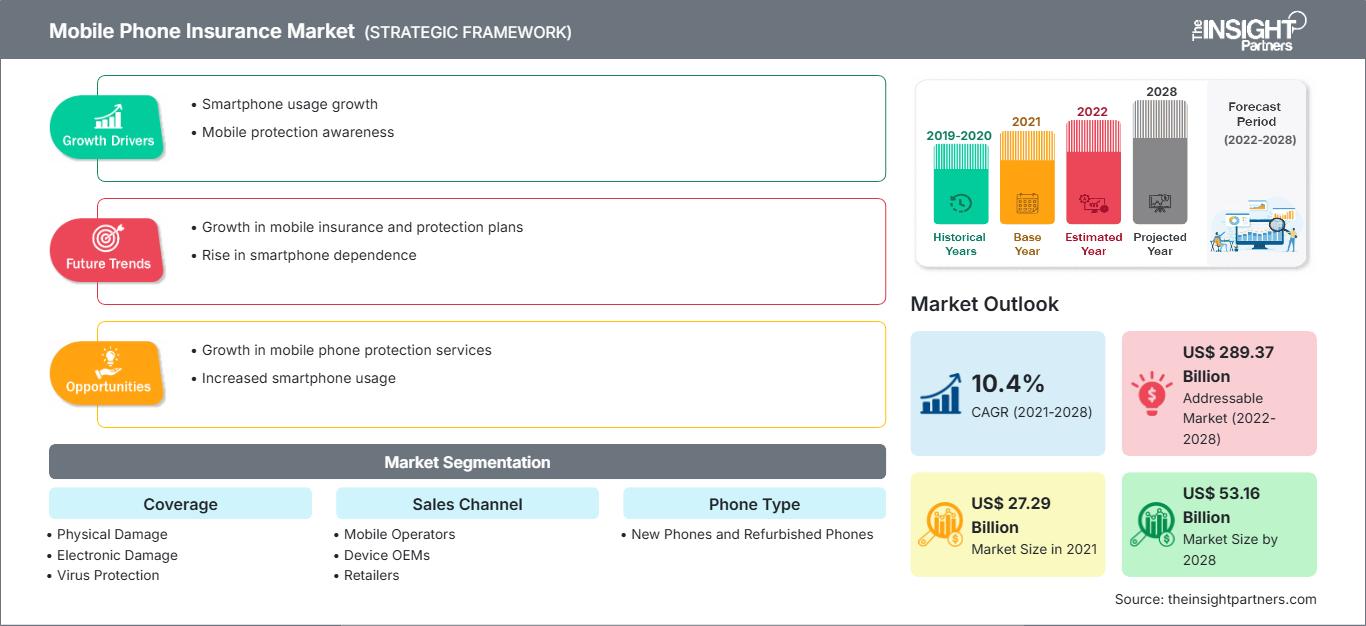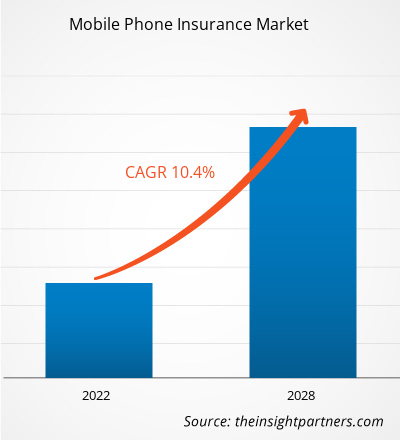[Forschungsbericht]Der Marktwert für Handyversicherungen wird voraussichtlich von 27.291,83 Millionen US-Dollar im Jahr 2021 auf 53.161,84 Millionen US-Dollar im Jahr 2028 steigen; von 2022 bis 2028 wird ein durchschnittliches jährliches Wachstum von 10,4 % erwartet.
Analystenperspektive:
Handyversicherungen sind ein schnell wachsender Markt, der Schutz für verlorene, gestohlene oder beschädigte Handys bietet. Der Markt ist hart umkämpft, und viele Unternehmen bieten unterschiedliche Tarife und Versicherungsoptionen an, um den vielfältigen Bedürfnissen der Verbraucher gerecht zu werden. Die hohen Kosten von Smartphones und das Bedürfnis nach Schutz vor Beschädigung oder Verlust treiben das Wachstum von Handyversicherungen voran. Diese Tarife decken in der Regel Unfallschäden, Diebstahl und Geräteverlust ab. Einige Tarife bieten zusätzlichen Schutz für Wasserschäden, Displayrisse und andere Probleme. Der Markt für Handyversicherungen wird voraussichtlich wachsen, da immer mehr Menschen Smartphones nutzen und nach Geräteschutz suchen. Der Trend zu häufigen Smartphone-Upgrades dürfte den Markt ebenfalls ankurbeln.
Marktübersicht:
Eine Handyversicherung ist ein Servicevertrag, der Komponenten- und Reparaturservices für von Einzelhändlern und Dienstanbietern verkaufte Handys umfasst. Sie bietet häufig zusätzlichen Schutz für Handys gegen Diebstahl, vorsätzliche Beschädigung, unbefugte Nutzung und E-Wallet-Transaktionen. Auch die Kosten und Unannehmlichkeiten mechanischer und elektrischer Probleme sind durch die Handyversicherung abgedeckt. Einer der Hauptgründe für das Wachstum des Handyversicherungsmarktes ist die Zunahme von Unfallschäden, Handydiebstahl, Virenbefall und Gerätedefekten. Ein weiterer wichtiger Faktor ist die zunehmende Verbreitung hochwertiger Smartphones. Darüber hinaus wächst der Markt für Handyversicherungen aufgrund der hohen Kosten für den Austausch wichtiger Komponenten. Eine Handyversicherung deckt in der Regel Sachschäden, interne Abdeckungsfehler, Diebstahl- und Verlustschutz sowie Viren- und Datenschutz ab.
Passen Sie diesen Bericht Ihren Anforderungen an
Sie erhalten kostenlos Anpassungen an jedem Bericht, einschließlich Teilen dieses Berichts oder einer Analyse auf Länderebene, eines Excel-Datenpakets sowie tolle Angebote und Rabatte für Start-ups und Universitäten.
Markt für Handyversicherungen: Strategische Einblicke

-
Holen Sie sich die wichtigsten Markttrends aus diesem Bericht.Dieses KOSTENLOSE Beispiel umfasst Datenanalysen, die von Markttrends bis hin zu Schätzungen und Prognosen reichen.
Markttreiber:
Steigende Verbreitung hochwertiger Smartphones treibt Wachstum des Handyversicherungsmarktes an
Die starke Verbreitung hochwertiger Smartphones treibt den Handyversicherungsmarkt aus mehreren Gründen an. Erstens sind hochwertige Smartphones teuer, und ihre Reparatur- oder Ersatzkosten können erheblich sein. Daher suchen Verbraucher zunehmend nach Geräteschutz durch Handyversicherungen. Diese Versicherungen decken in der Regel Unfallschäden, Diebstahl und Geräteverlust ab. Zweitens sind hochwertige Smartphones moderner und verfügen über mehr Funktionen als ihre Vorgängermodelle. Das bedeutet, dass sie anfälliger für Schäden durch Stürze, Wasser und andere Unfälle sind. Handyversicherungen bieten Schutz gegen solche Schäden, was für Verbraucher, die ihre Investitionen schützen wollen, unerlässlich ist. Drittens treibt die starke Verbreitung hochwertiger Smartphones den Handyversicherungsmarkt an, da die Nachfrage nach Schutz gegen Verlust oder Diebstahl steigt. Hochwertige Smartphones sind attraktive Ziele für Diebe, und das Verlust- oder Diebstahlrisiko ist höher als bei günstigeren Geräten. Handyversicherungen bieten Schutz vor solchen Risiken, was für Verbraucher, die ihre Investitionen schützen wollen, unerlässlich ist. Schließlich treibt die steigende Verbreitung hochwertiger Smartphones den Handyversicherungsmarkt an, da der Bedarf an Absicherung gegen Pannen und Störungen steigt. Hochwertige Smartphones sind komplexer als ihre Vorgänger und haben mehr Komponenten, die ausfallen können. Handyversicherungen können Schutz vor solchen Risiken bieten, was für Verbraucher, die ihre Investitionen schützen wollen, unerlässlich ist.
Segmentanalyse:
Basierend auf dem Versicherungsumfang wurde der Markt in Sachschäden, Elektronikschäden, Virenschutz und Diebstahlschutz segmentiert. Das Segment Sachschäden hatte 2020 den größten Marktanteil. Das steigende Bewusstsein für sexuell übertragbare Krankheiten und HIV hat weltweit zu einem Anstieg der Kondomnutzung geführt. Das Segment Sachschäden ist der bedeutendste Markt für Handyversicherungen und macht den größten Marktanteil aus. Das liegt daran, dass Smartphones zerbrechliche und teure Geräte sind, die leicht beschädigt werden können, und viele Verbraucher bereit sind, für eine Versicherung zu zahlen, die ihre Geräte vor Sachschäden schützt. Das Wachstum dieses Segments ist auch auf die weltweit zunehmende Verbreitung von Smartphones und die Beliebtheit von High-End-Smartphones zurückzuführen. Die Nachfrage nach Versicherungsschutz, der Smartphones vor Unfallschäden schützt, wird in den kommenden Jahren stark bleiben.
Regionale Analyse:
Der Markt für Handyversicherungen im asiatisch-pazifischen Raum wurde im Jahr 2021 auf 5.407,60 Millionen US-Dollar geschätzt und soll bis 2028 voraussichtlich 13.238,89 Millionen US-Dollar erreichen; im Prognosezeitraum wird mit einer durchschnittlichen jährlichen Wachstumsrate von 14,0 % gerechnet. Aufgrund mehrerer Schlüsselfaktoren ist Asien die am schnellsten wachsende Region im Markt für Handyversicherungen. Erstens erlebt die Region einen rasanten Anstieg der Smartphone-Durchdringung. Da immer mehr Menschen in Asien von einfachen Mobiltelefonen auf Smartphones umsteigen, erweitert sich der potenzielle Kundenstamm für Handyversicherungen erheblich. Dieser wachsende Markt von Smartphone-Nutzern schafft eine höhere Nachfrage nach Versicherungsschutz zum Schutz ihrer wertvollen Geräte. Zweitens verfügt die aufstrebende Mittelschicht in Asien über ein höheres verfügbares Einkommen und eine höhere Kaufkraft. Dadurch können sich mehr Menschen Smartphones leisten, die zunehmend zu einem unverzichtbaren Bestandteil des täglichen Lebens werden. Mit dem wachsenden Wert und der Bedeutung von Smartphones erkennen Verbraucher die Notwendigkeit, ihre Geräte vor versehentlicher Beschädigung, Diebstahl oder Verlust zu schützen. Dieses wachsende Bewusstsein für den Smartphone-Schutz treibt die Nachfrage nach Handyversicherungen in der Region an. Drittens haben Fortschritte im E-Commerce und bei digitalen Zahlungssystemen den Zugang und Abschluss von Handyversicherungen für Verbraucher in Asien erleichtert. Online-Plattformen und mobile Anwendungen bieten bequeme und optimierte Prozesse für den Abschluss von Versicherungsschutz und ziehen so einen größeren Kundenstamm an.
Zudem erleichtert die Verfügbarkeit verschiedener Zahlungsoptionen, darunter digitale Geldbörsen und Online-Banking, den Abschluss einer Handyversicherung für Verbraucher in Asien zusätzlich. Die wachsende Netzabdeckung und die verbesserte Internetverbindung in der Region haben zudem entscheidend zum Wachstum der Handyversicherungen beigetragen. Mit der verbesserten Konnektivität verlassen sich Nutzer stärker auf Smartphones für verschiedene Aktivitäten wie Kommunikation, Bankgeschäfte, Einkaufen und Unterhaltung. Diese zunehmende Abhängigkeit von Smartphones steigert den wahrgenommenen Wert des Versicherungsschutzes und veranlasst mehr Menschen, Schutz für ihre Geräte zu suchen. Schließlich hat der wachsende Trend zu gebündelten Versicherungsangeboten von Telekommunikationsanbietern und Geräteherstellern zum Wachstum des Handyversicherungsmarktes in Asien beigetragen. Diese Pakete kombinieren die Handyversicherung oft mit weiteren Leistungen wie Garantieverlängerungen, Datentarifen oder Geräte-Upgrades. Solche umfassenden Angebote bieten Kunden zusätzlichen Komfort und Mehrwert und machen Handyversicherungen attraktiv. Diese Faktoren, zusammen mit dem wachsenden Bewusstsein und der Bedeutung von Smartphone-Schutz, haben dazu beigetragen, dass Asien zur am schnellsten wachsenden Region im Handyversicherungsmarkt geworden ist.
Analyse der wichtigsten Akteure:
Die Analyse des Handyversicherungsmarktes umfasst Akteure wie Allianz, American International Group, Inc., Apple Inc., AT&T Inc., Aviva, Gadget Cover, Pier Insurance Managed Services Ltd. und Telefónica Limited. Unter den Akteuren im Handyversicherungsmarkt sind Apple Inc. und AT&T Inc., Inc. aufgrund ihres diversifizierten Produktportfolios die beiden größten.
Regionale Einblicke in den Markt für Handyversicherungen
Die Analysten von The Insight Partners haben die regionalen Trends und Faktoren, die den Markt für Handyversicherungen im Prognosezeitraum beeinflussen, ausführlich erläutert. In diesem Abschnitt werden auch die Marktsegmente und die geografische Lage in Nordamerika, Europa, dem asiatisch-pazifischen Raum, dem Nahen Osten und Afrika sowie Süd- und Mittelamerika erörtert.
Umfang des Marktberichts zur Handyversicherung
| Berichtsattribut | Einzelheiten |
|---|---|
| Marktgröße in 2021 | US$ 27.29 Billion |
| Marktgröße nach 2028 | US$ 53.16 Billion |
| Globale CAGR (2021 - 2028) | 10.4% |
| Historische Daten | 2019-2020 |
| Prognosezeitraum | 2022-2028 |
| Abgedeckte Segmente |
By Deckung
|
| Abgedeckte Regionen und Länder |
Nordamerika
|
| Marktführer und wichtige Unternehmensprofile |
|
Dichte der Akteure auf dem Markt für Handyversicherungen: Verständnis ihrer Auswirkungen auf die Geschäftsdynamik
Der Markt für Handyversicherungen wächst rasant. Die steigende Nachfrage der Endnutzer ist auf Faktoren wie veränderte Verbraucherpräferenzen, technologische Fortschritte und ein stärkeres Bewusstsein für die Produktvorteile zurückzuführen. Mit der steigenden Nachfrage erweitern Unternehmen ihr Angebot, entwickeln Innovationen, um den Bedürfnissen der Verbraucher gerecht zu werden, und nutzen neue Trends, was das Marktwachstum weiter ankurbelt.

- Holen Sie sich die Markt für Handyversicherungen Übersicht der wichtigsten Akteure
Jüngste Entwicklungen:
Anorganische und organische Strategien wie Fusionen und Übernahmen werden von Unternehmen im Markt für Handyversicherungen häufig genutzt. Nachfolgend sind einige wichtige Marktentwicklungen der letzten Zeit aufgeführt:
- Im Oktober 2020 gab Bolttech seine Partnerschaft mit Samsung in Thailand bekannt. Im Rahmen dieser Partnerschaft bietet Bolttech Besitzern von Samsung Galaxy Smartphones und Tablets über das Programm Samsung Care+ Reparaturdienste für Mobilgeräte an.
- Im Oktober 2021 gab Assurant die Übernahme von HYLA Mobile bekannt, einem führenden Anbieter von Lösungen für die Inzahlungnahme und Wiederverwendung von Mobilgeräten. Diese Übernahme soll Assurants Position im Markt für Handyversicherungen stärken, indem sie Kunden ein umfassenderes Lösungspaket bietet. Dank der Expertise von HYLA Mobile im Bereich Geräte-Inzahlungnahme und -Aufarbeitung kann Assurant seinen Kunden nachhaltigere und kostengünstigere Lösungen anbieten, gleichzeitig Abfall reduzieren und die Kreislaufwirtschaft unterstützen.
- Im März 2021 brachte SquareTrade eine neue Handyversicherung auf den Markt, die neben dem Standardschutz gegen Unfallschäden auch den Schutz bei Verlust oder Diebstahl von Geräten bietet. Das Produkt mit dem Namen „Lost and Stolen Protection“ ist sowohl für Neu- als auch für Bestandskunden von SquareTrade erhältlich und bietet bis zu 1.000 US-Dollar Deckung für verlorene oder gestohlene Geräte. Dieser Schritt soll der wachsenden Besorgnis von Smartphone-Nutzern hinsichtlich des Diebstahl- und Verlustrisikos Rechnung tragen und Kunden zusätzlichen Schutz bieten.
- Historische Analyse (2 Jahre), Basisjahr, Prognose (7 Jahre) mit CAGR
- PEST- und SWOT-Analyse
- Marktgröße Wert/Volumen – Global, Regional, Land
- Branchen- und Wettbewerbslandschaft
- Excel-Datensatz
Aktuelle Berichte
Verwandte Berichte
Erfahrungsberichte
Grund zum Kauf
- Fundierte Entscheidungsfindung
- Marktdynamik verstehen
- Wettbewerbsanalyse
- Kundeneinblicke
- Marktprognosen
- Risikominimierung
- Strategische Planung
- Investitionsbegründung
- Identifizierung neuer Märkte
- Verbesserung von Marketingstrategien
- Steigerung der Betriebseffizienz
- Anpassung an regulatorische Trends






















 Kostenlose Probe anfordern für - Markt für Handyversicherungen
Kostenlose Probe anfordern für - Markt für Handyversicherungen